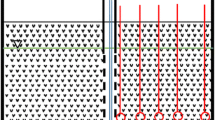Abstract
Purpose
The objective of the work is to determine the best operating conditions for variants of an ecological engineering tool (permeable reactive surface biobarrier -PRSB-) potentially useful for the protection of water resources, preventing the arrival of sediments and pesticides transported by runoffs and tile drainage from agricultural lands, to water bodies.
Methods
Four PRB-prototypes were constructed as fixed-bed horizontal channels packed with a porous material supporting an enriched microbial biofilm. Their dynamic and stoichiometric performance was evaluated in the presence or absence of granular activated carbon, with limiting or sufficient O2 supply. The removal of the pesticides and their leading catabolic derivatives were determined by HPLC. The most abundant cultivable microorganisms were isolated and identified by the sequencing of 16sDNA amplicons.
Results
The pollutant removal efficiencies obtained in the aerobic biobarriers or microaerophilia were similar. In addition, slight differences were observed in the presence of GAC as an adsorbent, meaning that the most economical and straightforward type of biobarrier was adequate to remove the pollutants studied. In addition, among the most abundant microorganisms isolated in the microbial biofilms colonizing the aerobic biobarriers, the microalgae Micractinium sp. showed the capacity to accumulate the insecticides permethrin and cypermethrin.
Conclusions
The main observed role of Micractinium sp. in the aerobic barriers was the bioaccumulation of pyrethroids, meaning that biosorption is also a valuable removal mechanism operating in the aerobic PRBs. In this aspect, they behave analogously to subsurface constructed wetlands but, instead of superficial plant life, aerobic PRSBs host microalgae.






Similar content being viewed by others
References
National Research Council. Barrier technologies for environmental management: summary of a workshop. Washington, DC.: The National Academies Press; 1997. https://doi.org/10.17226/5539.
Vo D, Ramamurthy AS, Qu J, Zhao XP. Containment wells to form hydraulic barriers along site boundaries. J Hazard Mater. 2008;160(1):240–243. https://doi.org/10.1016/j.jhazmat.2008.02.124
Patty L, Réal B, Gril JJ. The use of grassed buffer strips to remove pesticides, nitrate and soluble phosphorus compounds from runoff water. Pestic Sci. 1997;49(3): 243–251. https://doi.org/10.1002/(SICI)1096-9063(199703)49:3<243::AID-PS510>3.0.CO;2-8
Schultz RC, Isenhart TM, Simpkins WW, Colletti JP. Riparian forest buffers in agroecosystems – lessons learned from the Bear Creek Watershed, central Iowa, USA. Agrofor Syst. 2004;61:35–50. https://doi.org/10.1023/B:AGFO.0000028988.67721.4d.
Polprasert C, Kittipongvises S. Constructed wetlands and waste stabilization ponds. Treatise Water Sci. 2011;277–299. https://doi.org/10.1016/b978-0-444-53199-5.00090-7.
ITRC (Interstate Technology & Regulatory Council). Permeable reactive barriers: lessons learned/new directions. PRB-4. Washington, D.C.: Interstate Technology & Regulatory Council, Permeable Reactive Barriers Team; 2005. Available on the Internet at https://www.itrcweb.org.
Gavrilescu M. Emerging processes for soil and groundwater cleanup - Potential benefits and risks. Environ Eng Manag J. 2009;8(5): 1293–1307 http://omicron.ch.tuiasi.ro/EEMJ/.
Meggyes T, Simon FG, Debrenczeni E. New Developments in Reactive Barrier Technology. In: Sarsby RW, Meggyes T, editors. GREEN 3, 3rd International Symposium on Geotechnics Related to the European Environment. The exploitation of natural resources and the consequences. Thomas Telford Publishing 2000.
Castañón-González JH, Galíndez-Mayer J, Ruiz-Ordaz N, Rocha-Martínez L, Peña-Partida JC, Marrón-Montiel E, Santoyo-Tepole F. Biodegradation of the herbicide Diuron in a packed bed channel and a double biobarrier with distribution of oxygenated liquid by airlift devices: influence of oxygen limitation. New Biotechnol. 2016;33:7–15.
Simon J, Klotz MG. Diversity and evolution of bioenergetic systems involved in microbial nitrogen compound transformations. Biochim Biophys Acta Bioenerg. 2013;1827(2):114–135. https://doi.org/10.1016/j.bbabio.2012.07.005.
Pester M, Knorr K-H, Friedrich MW, Wagner M, Loy A. Sulfate-reducing microorganisms in wetlands – fameless actors in carbon cycling and climate change. Front Microbiol. 2012;3:72. https://doi.org/10.3389/fmicb.2012.00072.
Krzmarzick MJ, McNamara PJ, Crary BB, Novak PJ. Abundance and diversity of organohalide-respiring bacteria in lake sediments across a geographical sulfur gradient. FEMS Microbiol Ecol 2013;84:248–258.
Lloyd JR. Microbial reduction of metals and radionuclides. FEMS Microbiol Rev. 2003;27:411–425. https://doi.org/10.1016/S0168-6445(03)00044-5.
Andreoni V, Gianfreda L. Bioremediation and monitoring of aromatic-polluted habitats. Appl Microbiol Biotechnol 2007;76:287–308. https://doi.org/10.1007/s00253-007-1018-5.
Lojkasek-Lima P, Aravena R, Shouakar‐Stash O, Frape SK, Marchesi M, Fiorenza S, Vogan J. Evaluating TCE abiotic and biotic degradation pathways in a permeable reactive barrier using compound-specific isotope analysis. Ground Water Monit Remediat, 2012;32(4):53–62. https://doi.org/10.1111/j.1745-6592.2012.01403.x;.
Benner SG, Blowes DW, Ptacek CJ, Mayer KU. Rates of sulfate reduction and metal sulfide precipitation in a permeable reactive barrier. Appl Geochem. 2002;17(3), 301–332. https://doi.org/10.1016/S0883-2927(01)00084-1.
González-Cuna S, Galíndez-Mayer J, Ruiz-Ordaz N, Murugesan S, Piña-Escobedo A, García-Mena J, Lima-Martínez E, Santoyo-Tepole F. Aerobic biofilm reactor for treating a commercial formulation of the herbicides 2, 4-D and dicamba: biodegradation kinetics and biofilm bacterial diversity. Int Biodeterior Biodegrad. 2016;107, 123–31. https://doi.org/10.1016/j.ibiod.2015.11.014.
Cabrera-Orozco A, Galíndez-Nájera SP, Ruiz-Ordaz N, Galíndez-Mayer J, Martínez-Jerónimo FF. Biodegradation of a commercial mixture of the herbicides atrazine and S-metolachlor in a multi-channel packed biofilm reactor. Environ Sci Pollut Res. 2017;24(33):25656–25665. https://doi.org/10.1007/s11356-016-6204-5.
Abu-Qare AW, Abou-Donia MB. Simultaneous determination of malathion, permethrin, DEET (N, N-diethyl-m-toluamide), and their metabolites in rat plasma and urine using high-performance liquid chromatography. J Pharm Biomed Anal. 2001;26:291–9. https://doi.org/10.1016/S0731-7085(01)00407-1.
Abu-Qare AW, Abou-Donia MB. Simultaneous determination of chlorpyrifos, permethrin, and their metabolites in rat plasma and urine using high-performance liquid chromatography. J Anal Toxicol. 2001;20:275–9. https://doi.org/10.1093/jat/25.4.275.
Smith RT, Bangert K, Wilkinson SJ, Gilmour DJ. Synergistic carbon metabolism in a fast growing mixotrophic freshwater microalgal species Micractinium inermum. Biomass Bioenergy. 2015;82:73–86. https://doi.org/10.1016/j.biombioe.2015.04.023.
Yun H-S, Lee H, Park Y-T, Ji M-K, Kabra AN, Jeon C, Jeon B-H, Choi J. Isolation of novel microalgae from acid mine drainage and its potential application for biodiesel production. Appl Biochem Biotechnol. 2014;173(8):2054–64.https://doi.org/10.1007/s12010-014-1002-3.
Hong JW, Jo S-W, Cho H-W, Won Nam S, Shin W, Mok Park K, In Lee K, Yoon H-S. Phylogeny, morphology, and physiology of Micractinium strains isolated from shallow ephemeral freshwater in Antarctica. Phycol Res. 2015;63(3). https://doi.org/10.1111/pre.12097.
Sonmez C, Elcin E, Akın D, Oktem HA, Yucel M. Evaluation of novel thermo-resistant Micractinium and Scenedesmus sp. for efficient biomass and lipid production under different temperature and nutrient regimes. Bioresour Technol. 2016;211:422–428. https://doi.org/10.1016/j.biortech.2016.03.125.
Sáenz MA, Di Marzio WD, Alberdi JL. Effects of a commercial formulation of cypermethrin used in biotech soybean crops on growth and antioxidant enzymes of freshwater algae. Int J Environ Prot. 2012;2(1):15–22. https://doi.org/10.5963/IJEP0201003.
Wang Z, Yue W. Removal of cypermethrin with seaweed Graciilaria lemaneiformis. J Ocean Univ China. 2015;14:858–864. https://doi.org/10.1007/s11802-015-2567-3.
Mota da Silva V, Almeida Silva L, de Andrade JB, da Cunha Veloso MC, Vieira Santos G. Determination of moisture content and water activity in algae and fish by thermoanalytical techniques. Quím Nova. 2008;31(4). https://doi.org/10.1590/S0100-40422008000400030 (% Humidity in eight marine algae = 81.025 ± 11.29).
Dickinson S, Mientus M, Frey D, Dickinson S, Amini-Hajibashi A, Ozturk S, Shaikh F, Sengupta D, El-Halwagi MM. A review of biodiesel production from microalgae. Clean Technol Environ Policy 2017;19(3):637–668. https://doi.org/10.1007/s10098-016-1309-6.
Relman DA. Universal bacterial 16S rRNA amplification and sequencing. In: Persing HD, Smith TF, Tenover CF, White ST, editors. Diagnostic molecular microbiology. Principles and applications. Washington, DC: American Chemical Society; 1993. pp. 489–95.
Siti-Hajar MD, Noorhisham TK, Nurina A. Yeast identification from domestic ragi for food fermentation by PCR method. Int Food Res J. 2012;19(2):775–777.
Verma JP, Jaiswal DK, Sagar R. Pesticide relevance and their microbial degradation: a-state-of-art. Rev Environ Sci Biotechnol. 2014;13(4):429–466. https://doi.org/10.1007/s11157-014-9341-7.
Defarge N, Spiroux de Vendômois J, Séralinia GE. Toxicity of formulants and heavy metals in glyphosate-based herbicides and other pesticides. Toxicol Rep. 2018;5:156–163. https://doi.org/10.1016/j.toxrep.2017.12.025.
Tush D, Loftin KA, Meyer MT. Characterization of polyoxyethylene tallow amine surfactants in technical mixtures and glyphosate formulations using ultra-high-performance liquid chromatography and triple quadrupole mass spectrometry. J Chromatogr A, 2013;1319:80–87. https://doi.org/10.1016/j.chroma.2013.10.032.
Mayali X, Editorial: Metabolic interactions between bacteria and phytoplankton. Front Microbiol. 2018;9:727. https://doi.org/10.3389/fmicb.2018.00727.
Vymazal J, Březinová T. The use of constructed wetlands for removal of pesticides from agricultural runoff and drainage: A review. Environ Int. 2015;75:11–20. https://doi.org/10.1016/j.envint.2014.10.026.
Acknowledgements
This work was supported by the Instituto Politécnico Nacional, Secretaría de Investigación y Posgrado, (Grant SIP-IPN, 20180649). The authors thank COFAA-IPN and SNI-Conacyt for the scholarships awarded to NRO, CJR, and JGM; to Conacyt and SIP-IPN for a fellowship to ECB.
Author information
Authors and Affiliations
Corresponding author
Ethics declarations
Conflict of interest
The authors declare that they have no conflict of interests.
Additional information
Publisher's Note
Springer Nature remains neutral with regard to jurisdictional claims in published maps and institutional affiliations.
Rights and permissions
About this article
Cite this article
Contreras-Blancas, E., Ruiz-Ordaz, N., Galíndez-Mayer, J. et al. Permeable reactive surface-biobarriers. Testing and evaluation of an ecotechnology for the removal of agrotoxic compounds carried by agricultural runoffs. J Environ Health Sci Engineer 18, 559–571 (2020). https://doi.org/10.1007/s40201-020-00482-z
Received:
Accepted:
Published:
Issue Date:
DOI: https://doi.org/10.1007/s40201-020-00482-z




